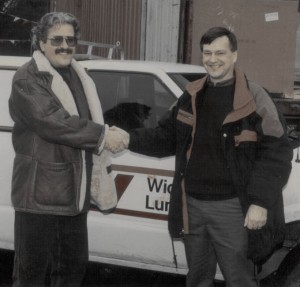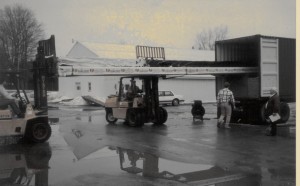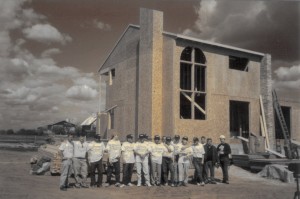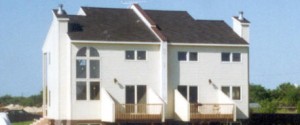Homebuilder and retiree export know-how from CNY to Poland
The houses rising in Europe look the same as those in Manlius.
By J. Trout Lowen. Staff Writer. Syracuse Herald-Journal. June 5, 1995
Amid the brick, concrete and stucco homes that stand as trademarks of communist-era Poland, something unusual is taking shape on Warsaw’s suburban landscape.
In Lomianki, 12 miles west of Warsaw, a dozen Polish carpenters are at work erecting a pair of wood-frame townhomes that wouldn’t look out of place in a Syracuse suburb.
That’s because the houses in the Dziekanow Fields development are modeled after a Linbrook Homes development on Route 92 in Manlius. They are being built with help and advice from two Central New Yorkers.
Memphis resident Paul Baldwin, an operations manager for Linbrook, spent two weeks in Poland this spring teaching Polish workers how to build with wood and nails instead of bricks and mortar. Mike Stasiw of Manlius, a retired mechanical contractor and co-owner of Morgan-Badgley Co. for 22 years, will be taking his expertise to Poland on June 18. A frequent visitor to Poland over the past 15 years, Stasiw said he knows what to expect.
“It’s a catch up. A real catch up for the last 30 or 40 years because they were behind that curtain (the Iron Curtain). Nothing new got behind that curtain,” he said.
Stasiw introduced Baldwin to Polish developer Leszek Budohoski (pronounced LAY-check BUDA hoski) last year. Stasiw had been helping Budohoski, a long-time friend, piece together his dream of building an American-style housing development in Poland.
“I took him around and showed him the project on Route 92 in Manlius. He loved it … Then his wife came over and she loved it,” Stasiw said. Budohoski asked Linbrook to estimate how much it would cost to ship materials to build a similar house to Poland. The question captured Baldwin’s fancy.
Wood-framed houses are rare in Poland. During the communist regime, homes were build out of masonry. Because construction materials were in constant short supply, construction was exceedingly slow. A single-family home could take anywhere from months to several years to build, Stasiw said. Under capitalism, building materials have become more available but expensive, he said.
Budohoski, a biochemist who spent time studying at Syracuse University on a Fuibright scholarship last year, figured he could build homes faster and cheaper by importing both materials and methods from the United States, even though tariffs and shipping fees will add about 60 percent to the cost of construction.
Polish labor is inexpensive. Workers earn about $2 an hour there. The town homes in Dziekanôw Fields will sell for the equivalent of about $150,000 American dollars, only slightly more than they might cost in Manlius. A similar Polish home would cost between $175,000 to $200,000, Baldwin said.
At first, Baldwin only intendedto helped Budohoski line up suppliers and purchase building materials. But Budohoski also needed experienced help, someone to go to Poland and teach his workers American construction methods. Baldwin tried to line up several prospects, but none worked out. Time was running out. The day the materials were shipped, Budôhoski asked Baldwin if he would be interested in the job.
“I had never expected (it) to be a possibility but it excited me, to have an opportunity to see more of this program come together,” he said.
On April 22, Baldwin and Eric Widger, a co-worker who had been laid off during a business slump, arrived in Lomianki. Although he had been taken to Poland to organize the work, Baldwin describes his two weeks as among the most physically challenging of his life. Baldwin had a goal for his stay, to get one side of the town house up, enclosed and ready to put the roof on; something that could easily be accomplished here.
“The reality of many of the days we were there for me was disappointment,” he said. There were fewer workers to do the job than Baldwin thought were needed, and the tools he had explicitly said were necessary for the work — such as heavy duty circular saws and ladders — weren’t there and weren’t easily available. A new specialty saw brought from the United States was never used because there was no electrical adaptor available. Tools that could be purchased weren’t up to the task. Among the poor tools were ladders Budohoski bought for the site.
“It was like a tripod-type ladder, very weak,” Baldwin recalled, shaking his head. “It had four legs, one was about 3 inches shorter than the other so when you stood on it, it would tip. It was very dangerous.”
The language barrier also added to the difficultly. The workers spoke only Polish and Baldwin and Widger only English. Instructions had to go through an interpreter. Some of the problems Baldwin had been told to expect didn’t materialize, however. He’d been cautioned that Polish workers were unmotivated and prone to bouts of heavy drinking. He found both to be untrue.
“Sometimes, when they wanted to see something accomplished, you almost had to slow them down. When they didn’t really care what was going on, you had to kind of encourage them to give you a hand,” he said. “Overall, I was impressed in that they learned things very quickly.”
Baldwin and the workers met his goal. They completed half the town house to the roof during his stay in less than two weeks, an accomplishment that was attracting gawkers daily.
Now that he’s back home, however, Baldwin wonders if he was able to teach the workers enough to finish the job in a way that will meet his standards. He’s giving instructions by telephone and over the fax machine.
A well-built house could convince Poles to try out the new American-style homes. That could mean more business for Budohoski, and possibly for Central New York suppliers.
Without seeing the finished product, Baldwin is unsure. “The question is, is it something that I would be proud to walk into and to put my name on?” he said.




